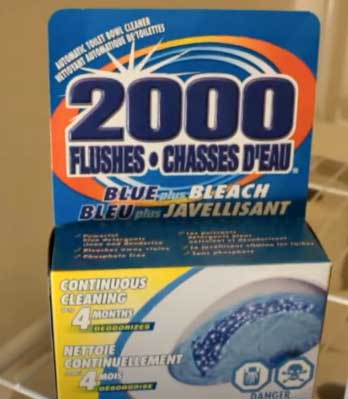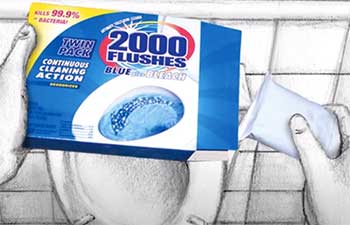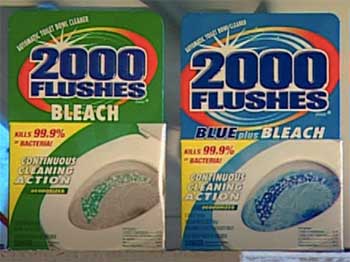It is not surprising that homeowners are always looking for a quick solution to clean their toilets. That is how in-tank tablets like 2000 Flushes became popular.
These tablets often contain bleach and chlorine, which are corrosive to the toilet’s internal components, pipes, and valves.
Along with quick toilet cleaning solutions, these tablets also bought about a bunch of common 2000 Flushes problems.
If you have not used one of these instant cleaning solutions yet, you are in for a surprise. In this article, I have listed some of the recurrent issues with 2000 Flushes. Brace yourself from here on!
What Are Some Of The 2000 Flushes Problems?

Like it or not, 2000 Flushes and similar tablets like this cause more trouble than help when it comes to maintaining toilets.
If you do not believe me, you will once you are done going through this article.
There is no end to the trouble instant toilet fixes can do to the different components of your toilet and even to the environment.
So, before you even lay eyes on toilet cleaning tablets like the 2000 Flushes, read the description below for a quick warning.
2000 Flushes Not Dissolving
Sometimes, 2000 Flushes tablet may refuse to dissolve into the tank water. These tablets are supposed to last for 3 months if the flush is used every day. If you do not flush every day, then there may be a problem.
So, what to do when your blue toilet tablet won’t dissolve?
Boil a gallon of water, and pour it into the toilet bowl after flushing once. Then, scrub the in-tank tablet with a scrubber to remove any debris stuck to it.
Now, please put it back into the tank, and pour another gallon of boiled water into the tank. Flush to finish the process.
If hot water could not dissolve the chunk, try some liquid bleach with hot water to help the tablet come apart. Warning: Mixing bleach with toilet cleaning products causes a severe chemical reaction that is harmful to your health.
Furthermore, you can also break the tablet into pieces before dropping them into the tank water. This should prevent it from malfunctioning in any way.
2000 Flushes Not Turning Water Blue
Many people have faced the issue of 2000 Flushes dissolving in the toilet tank first, but later on, becoming lighter and lighter. The rate at which the blue tablet dissolves slows down, making the water look less blue than expected.
In this situation, you can stir the tablet with a stick or something similar to that. This may help the surface wrap loosen up and release more of the blue hue.
Then, flush once or twice to check if the blue water is consistent. If not, flush two more times. This should solve the problem.
2000 Flushes Turns Pink
Chlorine in tap water can react with potassium and sodium nitrate and produce a brownish hue in the water. This is possible if you still use hard water and you have not done anything to soften it.

Moreover, potassium permanganate, which is normally used to oxidize manganese and iron, in tap water can create the same pink shade in the toilet water.
Water will turn purple when too much of this mineral is present in the waterline.
I can dive more into this. At the beginning of the product cycle, the color spectrum of 2000 Flushes can change from purple to blue.
Even if it takes on a reddish color, it means that the product is still doing its job and keeping your toilet clean.
Another factor that may affect the color of the water is the water temperature. This may be due to seasonal or regional issues. If having the pink color in the toilet is bothering you, remove the blue tablet to resolve it.
Lastly, there is more to the mystery than I initially thought. A type of bacteria called Serratia Marcescens survive on moisture, phosphates, and dust.
This bacteria can form pink stains in the toilet, which may be the reason your toilet water is turning pink.
You can observe this pink ring anywhere in the toilet bowl, in the shower or tub, around drains, and even dog bowls. Just dry the surface after use, and you can stop this bacteria from growing.
2000 Flushes Slows Down Your Toilet Flush
2000 Flushes tablets emit a stringy material which may sometimes clog the outlets around the rim of the toilet bowl. When the outlets get blocked, your toilet fails to bring about enough water around the rim to flush the toilet right.
Many people have had this trouble where they had to call a plumber after an incident, only to find out that a cleaning tablet was the culprit.
To solve this case, put on your long rubber gloves, scoop the tablet (in the form of a blasted sludge) out of the tank, and chuck it.
Even the ink that comes off of the tablet is hard to get rid of, so be very careful about not letting that drop around the toilet.
2000 Flushes Ruin Toilet Parts
2000 Flushes work by dissolving inside the toilet when it is dropped. The caustic materials and the tablet’s water react with rubber and plastic parts inside the toilet.

Part of the consequence of using tablets like these is leaking toilets and poor flushing power.
It is said that the longer you keep the 2000 Flushes tablet inside without flushing, the more time it takes to ruin the segments inside.
Based on advertisements, people just leave these tablets in their toilets for hours without being aware of how damaging it really is to the components inside.
Moreover, the bleach tablets are made of alkaline. So what happens is that the high-alkaline water eventually corrodes the various parts of your toilet without your knowing.
Rubber becomes brittle, flappers warp prematurely, and other components wear off quicker than they are supposed to.
Toilet tablet manufacturers do not cover for the damages caused by these in-tank tablets in their warranties. Therefore, you would be losing a ton of money in the process.
2000 Flushes Harms the Environment
The blue color that is common to 2000 Flushes tablet is infused with dangerous chemicals. They may help with cleaning the toilet but at a very high price.
The chemicals are not only releasing toxic fumes into your bathroom air but also to others rooms and the environment.
Wrapping It Up
It may be that the advertisers tricked you into purchasing in-tank toilets, and believe me, they are convincing! But after some time, you did notice all the 2000 Flushes problems depicted above.
Whether the tablet turned pink, failed to dissolve, slowed down your flush, or damaged your toilet parts, you have learned the lesson now.
As I always believe that nothing beats old-school methods of cleaning that involve simple cleaning soap, water, and scrubs. Honestly, you do not need any fancy tablet to keep your toilets clean.
Even simple solutions can go a long way without causing any major harm.


Agreed. After having the tablets in the toilet overnight the water turned black as the rubber seals in the tank were dissolving.
Running a hardware store, amazing reason to believe this article…